This website is supported by its readers. If you click one of my links I may earn a commission. I am also a participant in the Amazon affiliates program and I will also earn a commission from qualified purchases.
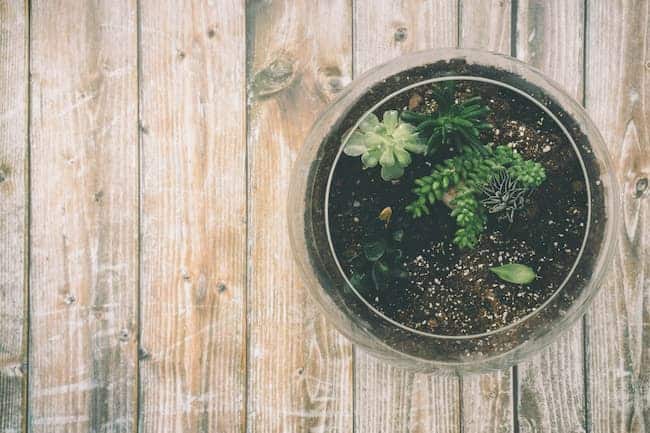
So, with the winter fast approaching, recently, I’ve been looking at ways to keep my bonsai trees indoors in a creative way. As such, I’ve become obsessed with something I’m a little ashamed to admit I didn’t know much about – Terrariums. So, can a bonsai tree live in a terrarium?
Tropical bonsai species such as Fukien Tea, Ficus, Bald Cypress, and Brazillian Rain Tree can grow successfully in terrariums. For best results, ensure the terrarium is open, the substrate is well-ventilated, and your bonsai are kept small.
Avoid putting conifers such as Juniper or Scots Pine bonsai in terrariums.
So, what are the advantages and disadvantages of growing your bonsai tree in a terrarium? And what is a full-depth list of bonsai trees you can grow in a terrarium? Keep reading to find out more!
Just a quick heads up, over the past three years of running Plantpaladin, hundreds of people have asked for product recommendations. As such, You can find my favorite indoor bonsai tree here (link takes you to Bonsaiboy), my favorite outdoor bonsai tree (link takes you to Bonsaiboy), or have a look at all the products I recommend here.
Can a bonsai tree live in a terrarium?
So, to get to the bottom of “Can a bonsai tree live in a terrarium,” I contacted my local botanical gardens, visited my local bonsai expert, and even surveyed ten Plant Paladin readers.
All to ensure that this post was as up-to-date and factual as possible.
Over the past few weeks, I’ve also tried experimenting with my bonsai.
To summarise:
- Some bonsai tree species can be grown successfully in terrariums.
- This works best for tropical deciduous trees such as Fukien Tea, Ficus, Bald Cypress, Brazilian Rain Tree, and even bonsai succulents like Jade.
- Now, it’s worth noting that not all bonsai trees can grow successfully in a terrarium, and trees that are more used to cooler climates, such as Oak or evergreen conifers such as Junipers or Pine bonsai, will have a hard time adapting to the terrarium.
- To successfully grow a bonsai in a terrarium, ensure that the bonsai tree is kept small, not more s than a one-handed sized bonsai tree, and is pruned regularly.
- You must ensure that the terrarium has plenty of ventilation, meaning that open terrariums will work best.
- Aim to have a substrate/soil mix that is well-ventilated and aerated to prevent mold infections such as root rot.
- If kept well and looked after by an experienced bonsai practitioner, bonsai trees can be grown successfully in terrariums for years.
- However, most will last between one and six months, and growing any plant in a terrarium, let alone a bonsai tree, can be challenging.
Now, this is a lot of information, so let’s break down this information in more detail.
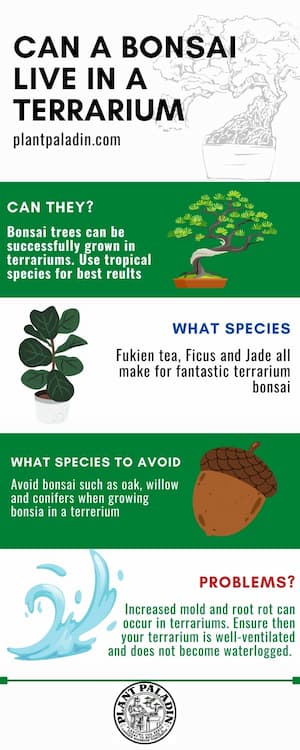
What are terrariums
So before we dive into the actual steps to grow a bonsai in a terrarium, it’s essential to know what a terrarium is.
Well, terrariums are seeable glass containers that are used to house a variety of plants.
Terrariums usually be opened to access the plant or have an opening that exposes them to the elements.
They are unique as they can create their mini-climate/ecosystem and are widely used to help grow tropical trees in sub-tropical environments.
Terrariums are a relatively new invention in botany, founded by Nathaniel Bagshaw Ward in 1842.
Many bonsai owners have taken to this invention to help add even more aesthetics to their trees.
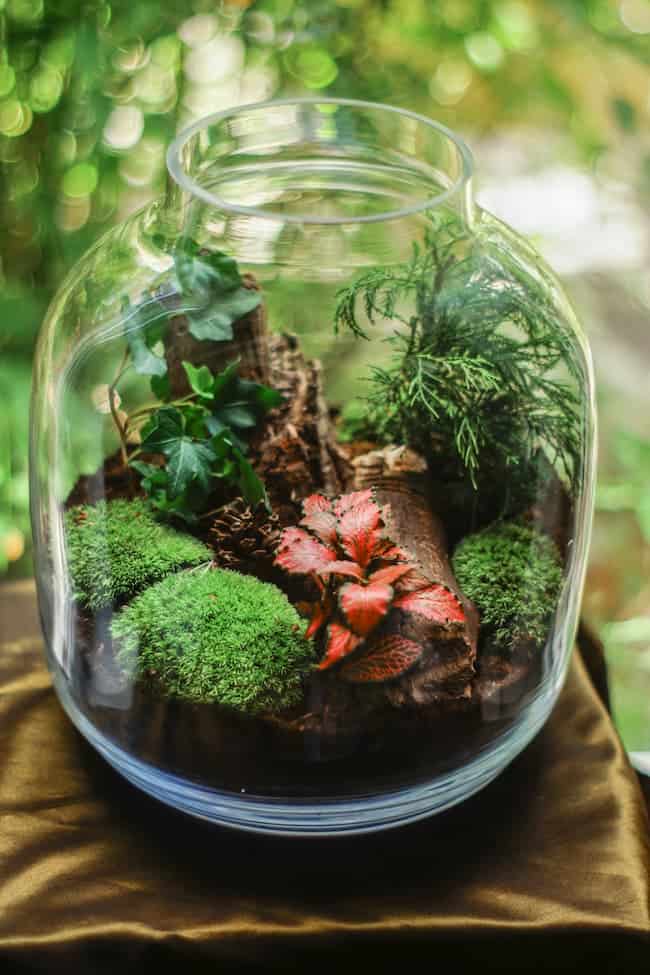
Is growing a bonsai in a terrarium easy?
So, while many of the other posts and advice I’ve seen about growing bonsai trees in a terrarium make out like doing so will be a walk in the park, growing a bonsai tree in a terrarium can be challenging.
You see, bonsai trees can be challenging to grow at the best of times due to the constant pruning and sunlight requirements needed.
Other plants, such as Ferns, are low-maintenance and can be adapted to the environment. You must stay vigilant when growing your bonsai trees in a terrarium.
Ensure that it gets plants of sunlight and aims to grow them in an open terrarium, preventing you from disrupting the environment too much.
What bonsai can I grow in a terrarium?
So now we know that it is possible to grow some bonsai tree species in terrariums; what species work the best?
Ginseng Ficus and other Ficus varieties, Fukien Tea, Brazilian rain tree, and Bald cypress trees can all be successfully grown in terrariums.
To help, I’ve compiled a complete list of bonsai trees that can be grown in a terrarium with ease in doing so:
Bonsai Tree
Difficulty Level
Ginseng Ficus
Beginner
Ficus Retusa
Beginner
Indian Banyan
Intermediate
Chinese Elm
Intermediate
Fukien Tea
Intermediate
Jade
Beginner
Bald Cypress
Advanced
Brazilian Rain Tree
Advanced
Ginseng Ficus
So, the first bonsai tree ideal for growing in a terrarium must be Ginseng ficus.
These are some of the most common bonsai trees used for keeping indoors, so this tree can easily be adapted to growth in a terrarium. These bonsai trees also have natural pest resistance and are incredibly beginner-friendly.
As such, I recommend it if this is your first time growing a bonsai in a terrarium.
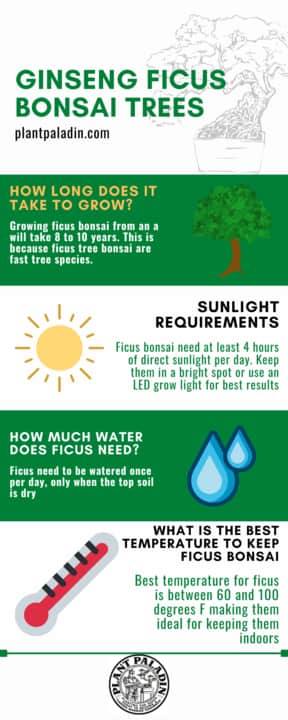
Ficus Retusa and Indian Banyan
Like Ginseng Ficus,l other ficus varieties commonly used for bonsai, such as Ficus Retusa or Indian Banyan, will also work incredibly well when growing bonsai in a terrarium.
Just ensure these trees meet sunlight requirements; growing them will be pretty straightforward.
Chinese Elm
Chinese Elm trees are easily among the most common bonsai trees in the world.
These, too, are incredibly beginner-friendly.
That said, growing them in a terrarium may be slightly more challenging due to these trees liking a nice breeze now and then.
Ensure that this bonsai, if grown in a terrarium, has plenty of ventilation.
Fukien Tea
Fukien Tea (Carmona retusa), often referred to as “Fukien Tea Tree” or simply “Fukien Tea,” is a tropical bonsai tree that can be a suitable choice for growing in a terrarium under the right conditions.
These trees naturally have a compact growth habit, making them well-suited for the limited space inside a terrarium. It typically reaches 10 to 15 inches when mature, ideal for small indoor environments.
Jade
One type of plant that thrives in terrariums is tropical succulents such as cacti.
Naturally, bonsai succulents such as Jade will have no problem adapting to a terrarium.
Of all the bonsai species, these can be left in a terrarium with little watering in the internal atmosphere, allowing the tree to meet its moisture needs.
Bald Cypress
The Bald Cypress (Taxodium distichum), or “Swamp Cypress,” is a unique and exciting tree that can be grown in a terrarium under specific conditions.
While there may be other choices for terrariums due to their size and specific habitat requirements, there are some reasons why it can be considered a good tree for terrarium cultivation.
The Bald Cypress is known for its distinctive, feathery foliage, which turns a beautiful coppery color in the fall before shedding. Its unique appearance can add visual interest to a terrarium.
Brazilian Rain Tree
The Brazilian Rain Tree (Pithecellobium tortum), also known as “Pau Ferro” or “Jabuticaba Havaiana,” can be an excellent tree to grow in a terrarium for several reasons.
Brazilian Rain Trees respond well to regular pruning and shaping, allowing you to maintain their size, form, and aesthetic qualities in a confined space.
Brazilian Rain Trees are known for their air-pruning roots. When grown in a pot or container, their roots tend to grow more slowly and are easier to manage, making them suitable for container gardening.
What bonsai should you avoid growing in a terrarium?
Oak, Willow, Pine, and juniper bonsai trees should not be grown in a terrarium. These trees either have heavy sunlight or watering requirements that a terrarium cannot meet.
A complete list of bonsai trees that you should avoid growing in a terrarium include:
- Oak
- Maple
- Pine
- Juniper
- Bougainvillea
- Beech
- Birch
- Willow
- Cedar
- Japanese Black Pine
- Conifers with Pyramidal Growth Habits
Other bonsai types you should avoid growing in terrariums
Aside from the species above, you should also avoid growing the following types of bonsai in terrariums:
Large or Fast-Growing Trees:
Bonsai trees that naturally grow large or rapidly can quickly outgrow the limited space inside a terrarium. These include species like Oak, Maple, or Pine.
High Light Requirement Trees
Bonsai trees that require intense, direct sunlight for most of the day are not well-suited for terrariums, which typically provide diffused or indirect light. Examples of such trees include Juniper and some types of Bougainvillea.
High Maintenance Trees:
Bonsai trees that demand frequent maintenance, such as intricate wiring or constant pruning, may be challenging to manage within the confined space of a terrarium. These trees can overwhelm beginners and may not thrive under terrarium conditions.
Species with Specialized Needs
Some bonsai species have specific temperature, humidity, or seasonal requirements that are difficult to replicate within a terrarium. Trees that require a dormant winter or specific cooling periods may not fare well in a terrarium.
Trees Prone to Disease or Pests
Bonsai species that are particularly susceptible to pests or diseases can pose a risk to other plants within the terrarium. For example, certain types of Ficus can be prone to spider mites.
Species with Invasive Roots
Trees with aggressive and invasive root systems, such as some Ficus, are unsuitable for terrariums, as their roots can quickly fill the available space and disrupt the ecosystem.
Water-Loving Trees
While some bonsai trees, like Brazilian Rain trees, can tolerate consistent moisture, species that require constantly wet conditions, like aquatic or marsh-loving plants, are not ideal for terrariums.
Bonsai Styles Requiring Space
Certain bonsai styles, such as the “literati” or “windswept” styles, often have branches extending beyond a terrarium’s confines. These styles may not be practical for a terrarium environment.
How to grow a bonsai tree in a terrarium?
So now we know what species work best in a terrarium; how exactly do you plant and grow a bonsai tree there?
Gather the right equipment.
So, before you start, you must grab all the equipment you need for your terrarium.
The following will be essential to grow your bonsai in a terrarium:
- A miniaturized-sized tropical bonsai such as Ficus, or Brazilian Rain trees. (aim for this to be no bigger than 20CM tall.
- An open or closed terrarium
- Pebbles or stones
- A breathable substrate soil
- Decorative rocks
- Sphagnum moss
- Sand
Clean the Terrarium Thoroughly
Begin your journey into terrarium gardening by ensuring your chosen container is sparkling clean.
Use warm, soapy water to wash the interior and exterior of the terrarium, and rinse it thoroughly. Allow it to air dry completely to prevent any moisture-related issues down the road.
Add a Thin Layer of Stones to the Bottom of the Terrarium
Proper drainage is crucial for the health of your bonsai, so start by adding a layer of small stones or pebbles to the bottom of the terrarium.
This layer will help prevent waterlogging, ensuring your bonsai’s roots remain healthy.
You can even use akadama or volcanic ash rock if you already use these in your bonsai soil.
Place bonsai soil on top of the rocks.
Once your drainage layer is in place, add a layer of bonsai-specific soil on top.
Bonsai soil is specially formulated to provide the necessary nutrients and aeration for your miniature tree. Ensure the soil layer is deep enough to accommodate your bonsai roots comfortably.
I found that a mix of pumice, volcanic ash rock, and Akadma works best for the best results.
Create a slope on One Side of the Terrarium.
Bonsai trees often feature naturalistic landscapes, complete with hills and valleys. Mimic this effect by gently sloping the soil to one side of your terrarium.
This not only adds visual interest but also helps with drainage.
This slope will then take up most of the space in the terrarium.
Add Decorative Rocks
Enhance the visual appeal of your bonsai terrarium by adding decorative rocks to the landscape.
These stones can be strategically placed to create paths, riverbeds, or other miniature features. Ensure they are clean and free of any contaminants.
Gently Place Your Bonsai Tree
Now, it’s time to introduce the star of the show – your bonsai tree.
Carefully remove your bonsai from its pot, not damaging the roots. Plant it in the soil, positioning it on the slope you created. Adjust the soil around the tree’s base to securely hold it.
You can then tightly pack any remaining sand and soil to the bonsai to hold it in place, or in extreme situations, use copper wire to hold your bonsai upright.
Add Sand and Rocks
Consider incorporating sand and small rocks to add more character to your terrarium. These can mimic gravel paths or create small, rocky outcrops. Arrange them as desired to complete the landscape.
Add Moss
Moss adds a beautiful, lush look to your terrarium and helps retain moisture.
Spread a layer of moss around the base of the bonsai tree and in any areas you want to cover. Gently press it into the soil to ensure good contact.
For best results, I like to use sphagnum moss, which can hold up to 8 times its weight in water.
Mist Your Terrarium
Maintain the humidity levels within your terrarium by misting it with water. Use a fine misting spray bottle to prevent over-saturation. Monitor the moisture level to ensure it remains consistently moist but not soggy.
Place the Terrarium in Its Final Location
Finally, choose a suitable location for your bonsai terrarium. It should receive indirect sunlight, as direct sunlight can cause excessive heat buildup within the terrarium. Monitor the humidity levels and water your bonsai when the soil dries out.
How to care for a bonsai tree in a terrarium
So now that you have successfully planted a bonsai in a terrarium, how exactly do you manage its ongoing care?
Watering
Like all trees, bonsai trees, especially tropical ones, require significant watering to keep them healthy and free from pests and fungal infections.
While you can water them outdoors, keeping them in a terrarium adds complexity.
As such, aim to water when the topsoil is dry; this will be less frequent than if planted in a pot but aim to water once to twice per week.
Use mosses to help keep moisture in the terrarium, and use a spritzer to not overfill the terrarium with water, which can lead to root rot.
Sunlight
Almost all bonsai trees require a significant amount of sunlight.
One of the challenges with keeping bonsai in a terrarium is that the glass can act as a magnifyet, which can either dry out your trees or burn their leaves.
Aim to keep your terrarium near a window with partial light, such as netting, which evenly disperses the sunlight.
Alternatively, plug an artificial grow light into your terrarium if winter or sunlight is less typical.
Most tropical bonsai can get by with about 5 hours of sunlight daily.
Soil
Ensure you use the correct soil when growing your bonsai in a terrarium.
For best results, use soil with a neutral PH level.
For most tropical bonsai, such as Ficus, consider using an inorganic mix with equal parts akadama, volcanic ash rock, and pumice.
This will give an even level of aeration, water retention, and moisture flow, leading to a happy, healthy bonsai.
Temperature
One of the significant challenges with terrariums is that it can be easy for temperatures to become too warm in them.
Aim then to keep your bonsai at around the same temperature year-round.
For best results, I will keep your tropical bonsai between 70 and 74 degrees F.
Pruning
Your bonsai tree will grow even in a terrarium, so you must monitor and prune it to avoid it becoming too big or, even worse, breaking your terrarium.
General maintenance pruning can be undertaken every few weeks in the spring and summer.
Just ensure you give it some time to recover from the process.
Much larger structural printing where you trim back your bonsai branches/trunk or style your bonsai ideally needs to be undertaken only once per year.
In these situations, I would repot your bonsai into a shallow pot while undertaking this process, then put it back in the terrarium.
Fertilizer
Aim to fertilize your bonsai once to twice per month in the spring and summer months.,
Avoid fertilizing in the inter.
Use a balanced fertilizer with an equal N-P-K ratio for best results.
Mold
Mold can be a common issue in terrariums due to the high humidity. Prevent and manage mold growth with these tips:
a. Adequate Ventilation: Ensure your terrarium has proper ventilation to prevent excess moisture buildup, which can lead to mold growth.
b. Remove Affected Areas: If you spot mold, remove affected leaves or moss promptly and adjust your watering routine to reduce humidity.
Repotting shock
Your bonsai might have a sudden shock if you have recently moved it into a terrarium.
Just note that this is perfectly normal.
The main symptom will be yellowing, bruised, or damaged leaves.
Trim the damaged leaves in this scenario to make way for new growth.
Pests
One of the significant downsides of terrariums is once you get a pest infestation, this can spread rapidly.
As such, consider keeping predatory insects such as ladybugs in your terrarium to take care of any pests that want to feed on your bonsai.
How big should a bonsai be for a terrarium?
Bosnia trees should be no larger than 15 to 20cm for terrariums. This is because larger or fast-growing bonsai trees need help adapting to the confined environment. Ensure then that you are only using a fingertip or one-handed bonsai.
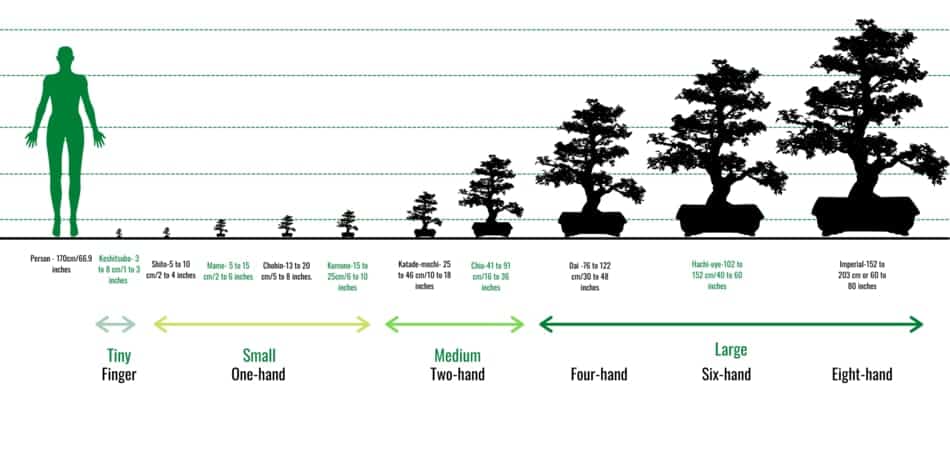
How much should a bonsai tree weigh for a terrarium?
Aim for your bonsai tree to weigh no more than 500 grams if growing in a terrarium. The larger and heavier a bonsai tree, the more chance it is for damage to occur both to the tree and the terrarium.
Benefits of growing a bonsai in a terrarium
The main benefits of growing a bonsai in a terrarium are:
Controlled Environment: Terrariums offer a controlled microclimate with stable humidity levels, which can benefit certain bonsai species, particularly those that thrive in tropical or high-humidity conditions.
Protection from Pests and External Factors: A terrarium can protect against pests, extreme temperatures, and drafts, helping to maintain the health and appearance of your bonsai.
Aesthetic Appeal: Bonsai trees in terrariums create captivating and visually appealing miniature landscapes that can serve as unique decorative pieces and conversation starters in your home.
Problems with growing a bonsai tree in a terrarium
The main challenges with growing bonsai in a terrarium are:
Limited Space for Growth: The confined space within a terrarium can restrict the growth of your bonsai, potentially leading to stunted development and the need for more frequent pruning and maintenance.
Care Challenges: Maintaining the right balance of humidity, temperature, and light within a terrarium can be challenging. It may require more attention and a learning curve to meet the specific needs of your bonsai species.
Unsuitability for Some Species: Not all bonsai species are suitable for terrariums, as some require more space, air circulation, and exposure to natural elements. Choosing the wrong species for a terrarium can lead to poor growth or even the demise of the bonsai.
Best terrariums for bonsai
Now, to determine what the best terrariums for your bonsai will be, you need to take into account the following:
Size
Shape
Material: Terrariums are available in glass, acrylic, and plastic. Glass terrariums are famous for their aesthetics and clarity, allowing you to showcase your bonsai beautifully. Acrylic and plastic terrariums are lighter and more durable but may have a different visual appeal than glass.
Lid or Open-Top: Decide whether you want a terrarium with a lid or an open-top design. Closed terrariums with lids create a more controlled environment with higher humidity levels, making them suitable for tropical bonsai species. Open-top terrariums offer better air circulation and may be better for species that prefer drier conditions.
Ventilation: If you choose a closed terrarium, ensure adequate ventilation. Look for models with built-in vents or add them to prevent mold and fungal growth.
Accessibility: Consider how easy it is to access your bonsai for maintenance tasks like pruning, watering, and repotting.
How to trim a terrarium bonsai?
Now, trimming a bonsai in a terrarium is no easy feat, but this comes down to what type of trimming you are doing:
- General maintain trimming
- Large structural strimming.
General light trimming can be undertaken quickly.
Simply remove the lid of your terrarium, and using a pair of shears, trim back the branches and leaves to maintain the silhouette of your tree.
For larger structural trimming, I would avoid undertaking this in your terrarium.
Instead, re-pot your bonsai in a pot, give it a few weeks to recover, and then trim back its branches and trinks to the desired effect.
Wait a few more weeks,s then repot back into the terrarium.
How often should you water bonsai in a terrarium?
Aim to water your bonsai in a terrarium once to twice per week. Most terrariums will contain water and moisture, meaning you must water them much less frequently. Avoid overwatering, which can cause mold infections like root rot.
How long do plants in terrariums last?
The average lifespan of a plant in a terrarium is about one year. At this stage, plants must be removed and grown in a pot for a year before being moved back into the terrarium. Most plants will live between four months and two years if grown solely in a terrarium.
Survey results
Finally, I wanted to fish off by asking ten Plant Paladin readers if a bonsai tree liver in a terrarium – here were the results.
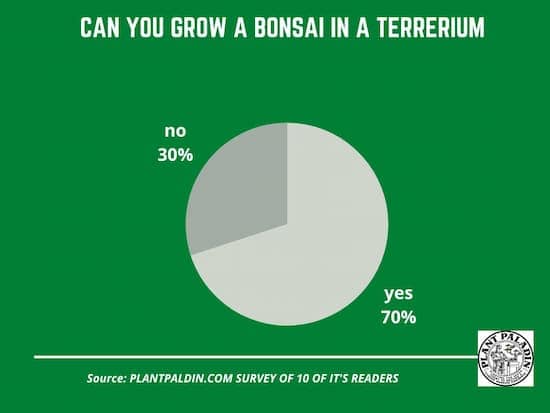
My top picks for the gear you will need!
So like I mentioned earlier, over the past three years of running PlantPaladin, hundreds of people have asked me for my recommendations on the best bonsai gear on the market.
Having spent thousands of dollars on bonsai items these past few years and tested at least 100 bonsai-specific products, I’ve listed my favorite products below – All of which I highly recommend and think you can get great value.
They can purchase directly by clicking the link to take them to Amazon.
Bonsai Tool Set: One of the significant challenges I’ve had is finding a toolset that was not only durable but didn’t break the bank. SOLIGT has recently developed a fantastic bonsai tool set that covers all the tools you need to trim, prune, and repot your trees. – You can grab it here.
Complete Bonsai Set: Many of you will want to grow your bonsai trees entirely from scratch, but finding the varicose seeds, pots, and other items in one place can be challenging. Leaves and Sole then have created a complete bonsai set that I’ve personally used that ticks all the boxes. You can grab it here.
Bonsai wire: The number of times I’ve run out of wire for my bonsai or purchased cheap bonsai wire that doesn’t do the job is embarrassing for me to admit. After a lot of trial and error, I found that using Hotop’s aluminum bonsai wire is one of the best options on the market. This can easily be used for both indoor and outdoor bonsai. You can grab it here.
